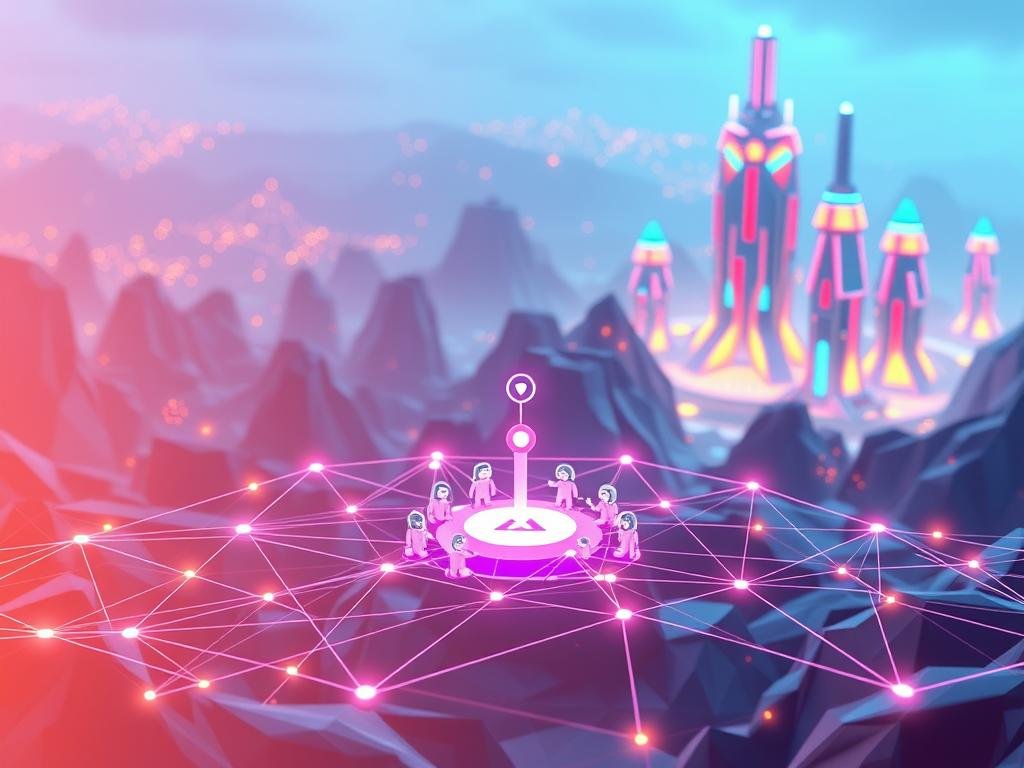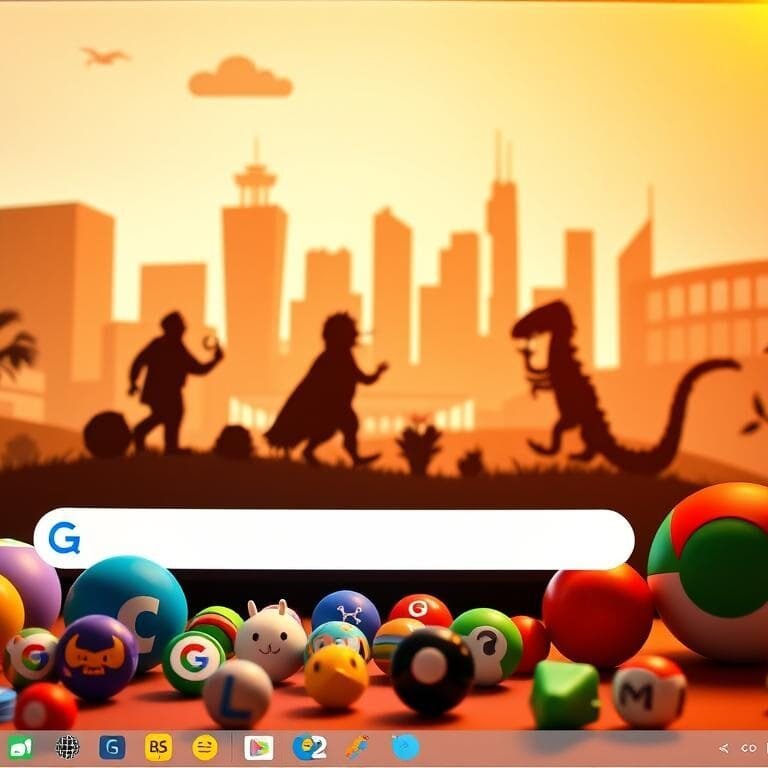A big change is coming to the internet. By 2025, over $27 billion will go into decentralized projects. This will change many industries. The internet has grown a lot, and Web3 is the next big step. It will make the internet more decentralized and focused on users.
Blockchain technology is key to this change. It makes data safe, open, and controlled by no one. As you learn about Web3, you’ll see how it can change many areas, like finance and entertainment.
Key Takeaways
- The internet is evolving into a more decentralized and user-centric platform.
- Web3 technologies, such as blockchain, are driving this change.
- Decentralized projects are expected to attract significant investment by 2025.
- The decentralized web promises enhanced security and transparency.
- Understanding Web3 principles is key for the future internet.
The Evolution of the Internet: From Web1 to Web3
The internet has changed a lot, from the early days of Web1 to the new Web3. This change has made online interactions different and changed the internet’s structure.
Web1: The Read-Only Era
Web1 started in the early 1990s. It was all about static websites. People could only read information online, not interact much. Websites were simple, with little graphics and no changing content.
Web2: The Interactive Social Web
Web2 came in the late 1990s and early 2000s. It brought social media, blogs, and more. Now, people could not only read but also create and share content. The web became more lively, thanks to new technologies.
Web3: The Decentralized Internet
Web3 is a big step forward, focusing on decentralization and putting users first. It uses blockchain technology for a secure and fair network. This means users have more control over their data and identity.
The move from Web1 to Web3 is more than just tech updates. It’s a big change in how we use the internet. Let’s look at the main differences between each era.
| Feature | Web1 | Web2 | Web3 |
|---|---|---|---|
| Primary Function | Read-only, information dissemination | Interactive, social, user-generated content | Decentralized, user-centric, blockchain-based |
| User Interaction | Limited, static content | Dynamic, social media, user-generated content | Decentralized applications (dApps), token-based |
| Data Control | Centralized | Centralized, with some user control | Decentralized, user-controlled |
Understanding the shift from Web1 to Web3 is key as we move towards a more decentralized internet. This journey shows us the tech progress and how user interaction and data control have changed.
Web3, Blockchain, and Decentralization: Core Concepts
Web3 is built on key ideas like blockchain technology and decentralization. These concepts help make the internet more secure, open, and focused on users.
Defining the Web3 Paradigm
The Web3 model is different from the old internet. It uses decentralized networks and blockchain for better security and control. It’s like an internet where you have more say over your data and how you interact.
“Web3 is not just a new technology, it’s a new paradigm that enables a more open, transparent, and secure internet.”
Web3 is based on decentralization, openness, and working together. These ideas help create a place where you can easily and safely use different services and platforms.
The Role of Blockchain Technology
Blockchain is the heart of Web3. It’s a decentralized and unchangeable ledger for transactions and data. This makes sure data is safe and open, perfect for secure applications.
Blockchain lets us make smart contracts. These are contracts that run on their own, making things more efficient and cutting out middlemen.
| Key Features | Blockchain Benefits |
|---|---|
| Decentralized Network | Increased Security and Transparency |
| Immutable Ledger | Tamper-Proof Data Storage |
| Smart Contracts | Automated Processes and Reduced Intermediaries |
Principles of Decentralization
Decentralization is key to Web3. It spreads power and control away from one place. This is done with blockchain and peer-to-peer networks, letting you connect directly with others.
- Distributed Ledger Technology: Keeps data from being controlled by one person.
- Peer-to-Peer Transactions: Lets you deal directly with others.
- Open-Source Software: Makes things clear and gets people involved.
By using decentralization, Web3 makes the internet stronger, clearer, and fairer. As you learn more about Web3, you’ll see how these ideas are used in many places.
How Blockchain Technology Powers Web3
The backbone of Web3 is blockchain technology. It offers a decentralized, immutable ledger for data management. This technology is key for a secure, transparent, and community-driven internet.
Understanding Blockchain Architecture
Blockchain architecture is the structure of a blockchain network. It includes nodes, consensus mechanisms, and data storage. A typical blockchain has a network of nodes that validate and record transactions on a distributed ledger.
The main parts of blockchain architecture are:
- Nodes: Computers that connect to the blockchain network and validate transactions.
- Consensus Mechanism: Algorithms used to achieve agreement among nodes on the state of the blockchain.
- Distributed Ledger: A decentralized database that stores all transactions made on the blockchain.
Types of Blockchains You Should Know
There are several types of blockchains, each with its own characteristics and uses:
- Public Blockchains: Open-source blockchains that allow anyone to join and participate, such as Bitcoin and Ethereum.
- Private Blockchains: Restricted blockchains that are controlled by a single entity, often used for enterprise solutions.
- Consortium Blockchains: Hybrid blockchains that are controlled by a group of organizations, balancing decentralization and control.
- Hybrid Blockchains: Blockchains that combine public and private blockchain elements, providing flexibility and scalability.
Exploring Consensus Mechanisms
Consensus mechanisms are vital for blockchain technology. They help nodes agree on the blockchain’s state. Common mechanisms include:
- Proof of Work (PoW): A mechanism used by Bitcoin, requiring nodes to solve complex puzzles to validate transactions.
- Proof of Stake (PoS): A mechanism that requires nodes to stake their own cryptocurrency to validate transactions, used by Ethereum 2.0.
- Delegated Proof of Stake (DPoS): A variant of PoS that allows users to vote for validators, used by EOS.
Understanding blockchain architecture, types of blockchains, and consensus mechanisms helps appreciate blockchain’s role in Web3. It shows how blockchain can make the internet more secure and decentralized.
Building and Using Decentralized Applications (dApps)
Web3 is changing how we use the internet with decentralized applications (dApps). These apps use blockchain for a safer, more open way to interact online. This change is making a big impact in many areas and giving new chances for developers and users.
What Makes an Application Truly Decentralized
A true dApp runs on blockchain, working on its own without a single boss. Decentralized governance means users make decisions, often by voting with tokens. This stops one person from controlling everything.
dApps are open-source, so anyone can see and change the code. This openness helps the app grow stronger and safer. They also use cryptographic techniques to keep data and transactions safe.
Examining dApp Architecture
A dApp’s design is key to its success. It has a front-end for users and a back-end for blockchain work. The front-end is built with common web tools, while the back-end runs smart contracts.
The architecture also includes blockchain protocols like Ethereum. These protocols help store data and handle transactions. Knowing this is vital for making dApps that work well and are secure.

Popular dApp Categories and Examples
dApps come in many types, each with its own benefits. Here are some of the most popular:
- DeFi (Decentralized Finance): Apps like Uniswap and Aave change finance by letting you lend, borrow, and trade without banks.
- Gaming: Games like Axie Infinity and Decentraland let players own and sell in-game items, making gaming more rewarding.
- Social Media: Sites like Steemit pay users in crypto for their content, shaking up social media.
These examples show how dApps are making a big difference. As Web3 grows, we’ll see even more cool and useful dApps.
Implementing Smart Contracts in Web3
As we explore Web3, smart contracts play a key role. They are self-executing contracts with code that automates decisions. This makes them a cornerstone of decentralized systems.
Functionality of Smart Contracts
Smart contracts automate agreements, cutting out the middleman. They live on a blockchain, making them secure and open. When conditions are met, they carry out actions as programmed.
Key features of smart contracts include:
- Autonomy: They run processes without needing others.
- Trust: They ensure trust through clear and secure execution.
- Efficiency: They save time and money compared to traditional contracts.
Comparing Smart Contract Development Platforms
Many platforms help develop smart contracts, each with its own strengths. Ethereum, Polkadot, and Solana are among the most popular. Developers should look at scalability, security, and ease of use when choosing.
Ethereum is a top choice for smart contract development. It has a strong ecosystem and tools for developers. Polkadot, on the other hand, allows for easy interaction between blockchains, making smart contracts more versatile.
Real-World Applications of Smart Contracts
Smart contracts are used in many fields. They help in DeFi for lending and borrowing, in supply chain management, and in governance for voting.
In insurance, smart contracts can speed up claims processing. In real estate, they make buying and selling property more efficient and clear.
By using smart contracts, you can help build a more decentralized and efficient internet in Web3.
Navigating Decentralized Finance (DeFi) Ecosystems
Exploring Web3 means learning about Decentralized Finance (DeFi). DeFi changes the financial world by providing new, open ways to manage money.

Understanding DeFi Fundamentals
DeFi uses blockchain to create new financial tools. It offers lending, borrowing, and trading without banks. This makes finance open to everyone with the internet.
You can join DeFi through decentralized exchanges and lending platforms. These use smart contracts for safe, clear transactions.
Exploring Key DeFi Protocols and Services
Many important DeFi tools have come up, like:
- Lending Protocols: Platforms like Compound and Aave let you lend and earn interest on cryptocurrencies.
- Decentralized Exchanges (DEXs): DEXs like Uniswap and SushiSwap let you trade cryptocurrencies without banks.
- Stablecoins: Stablecoins like DAI and USDC are stable in the shaky crypto market.
These tools are key to DeFi, giving users many financial options.
Assessing Risks and Opportunities in DeFi
DeFi has big chances but also big risks. Smart contract risk is a big worry, as bugs can cause money loss. Also, DeFi laws are changing and could affect some projects.
To deal with these risks, do your homework before getting into DeFi. Knowing the risks and chances helps you make smart choices and grab DeFi’s benefits.
Creating and Trading Non-Fungible Tokens (NFTs)
NFTs have changed how we see ownership and scarcity online. They are key to the Web3 world, mixing art, tech, and investment chances.
Uniqueness of NFTs
NFTs are non-fungible tokens that stand for unique digital items. They’re not like cryptocurrencies, which can be swapped. NFTs are special because they can’t be replaced by another one. This is thanks to blockchain, which keeps track of who owns what.
You can make NFTs for different digital stuff, like art, music, or virtual land. The ownership and rarity of these items are checked on the blockchain. This makes them rare and valuable.
Navigating NFT Marketplaces
NFT marketplaces let you buy, sell, and trade NFTs. Places like OpenSea, Rarible, and SuperRare are popular. It’s important to know the fees for making, buying, and selling NFTs when you’re on these sites.
- Look into the marketplace’s reputation and who uses it.
- Get the lowdown on transaction and NFT creation fees.
- Make sure the NFTs you buy are real and owned by the seller.
Expanded Use Cases Beyond Art
NFTs are not just for art anymore. They’re used in many fields, like:
- Virtual real estate and metaverse experiences.
- Music and entertainment, for special content.
- Gaming, for in-game items and characters.
As Web3 grows, so will the ways NFTs are used. This opens up new chances for creators, collectors, and investors.
Participating in Decentralized Autonomous Organizations (DAOs)
In the world of Web3, DAOs are becoming more important. They are a new way to make decisions together using blockchain. This makes governance more open and fair.
DAO Structure and Operation
A DAO is a group that makes decisions without a leader. Decentralized autonomous organizations use smart contracts to guide their actions. It’s like a digital group where everyone gets a say.
DAOs have a system where members vote based on how many tokens they have. The more tokens, the more say you have. This way, everyone’s voice is heard equally.

Voting and Decision-Making in DAOs
Voting is key in DAOs. It lets members decide on important issues. The outcome is based on a consensus, like a simple majority vote.
Some DAOs use special voting systems. For example, quadratic voting gives more weight to smaller token holders. This makes decisions more fair for everyone.
“DAOs are not just a new way of organizing people; they represent a fundamental shift in how we think about governance and collective decision-making.”
Notable DAO Examples
Many DAOs are making waves in Web3. They show how decentralized governance can work. Check out the table below for some examples.
| DAO Name | Focus Area | Voting Mechanism |
|---|---|---|
| MakerDAO | Decentralized Finance (DeFi) | Executive Voting |
| Uniswap | Decentralized Exchange | Governance Voting |
| Aragon | DAO Infrastructure | Token-based Voting |
These DAOs show the variety and promise of decentralized governance. Exploring DAOs can open up new ways to make decisions together.
Essential Web3 Development Tools and Technologies
When you start with Web3 development, you’ll learn about key tools and technologies. Web3 is complex, needing knowledge of blockchain, decentralized networks, and tools for building Web3 apps.
Setting Up Your Web3 Development Environment
To begin with Web3 apps, you must set up a good development environment. You’ll need to install tools like Node.js, Truffle Suite, and Ganache. Truffle Suite helps with smart contract building, testing, and deployment. Ganache lets you test on a local blockchain.
“A well-set environment is key for efficient Web3 development,” experts say. A good setup can make your work easier.
Choosing Programming Languages for Web3
Web3 supports many programming languages, each with its own benefits. Solidity is top for Ethereum smart contracts. Rust and JavaScript are also popular for their performance and versatility.
- Solidity for Ethereum smart contracts
- Rust for high-performance blockchain apps
- JavaScript for front-end work and Web3 API interactions
Testing and Deploying Your Web3 Applications
Testing is vital in Web3 to ensure apps are secure and work right. Tools like Truffle and Ganache help test smart contracts. When ready, choose a blockchain network based on cost, scalability, and security.
Deployment strategies might use layer 2 solutions or sidechains for better performance and lower costs. It’s important to watch your app’s performance after deployment and update as needed.
“The key to successful Web3 development lies in rigorous testing and a well-planned deployment strategy.” – Web3 Development Expert
Overcoming Web3 Challenges and Limitations
Web3 has a lot of promise but faces big hurdles for it to be widely used. We need to understand the obstacles and how to get past them as we move towards a decentralized internet.

Addressing Technical Scalability Issues
One big problem with Web3 is making it scale. As more people use it and more transactions happen, it must stay fast and secure.
Scalability solutions like sharding and layer 2 scaling are being worked on. These aim to make blockchain networks handle more without slowing down.
Improving User Experience in Web3
Web3 needs to be easier for everyone to use. Right now, using decentralized apps can be hard and scary for newcomers.
Developers are making apps easier to use and streamlined onboarding processes. Making it simple for new users is key to Web3 becoming mainstream.
Navigating Regulatory and Legal Considerations
The rules for Web3 are changing and differ by place. It’s hard for developers and users to keep up with these laws.
Regulatory clarity is needed for Web3 to grow. We need clear rules on data privacy, money rules, and who owns what in the digital world.
As Web3 grows, tackling these issues is vital. By working on scalability, making it user-friendly, and following the law, we can make the decentralized internet a reality.
Getting Started with Web3: Your First Steps
Starting your Web3 journey means learning about the tools and tech behind this new internet. You’ll need a Web3 wallet, know about decentralized apps, and find learning resources.
Setting Up Your Web3 Wallet
A Web3 wallet is key for using the decentralized web. It helps you manage cryptocurrencies and smart contracts. Here’s how to set one up:
- Choose a trusted wallet provider like MetaMask.
- Make a strong password and keep your recovery phrase safe.
- Learn about transaction fees and how to adjust your wallet settings.
Interacting with Your First Decentralized Applications
Decentralized apps (dApps) are vital in Web3, providing services from finance to fun. Here’s how to use them:
- Check out dApp marketplaces like DAppRadar for new apps.
- Link your Web3 wallet to the app and know what permissions you’re giving.
- Begin with basic actions, like trading or joining a community.
Best Learning Resources for Web3 Development
For those eager to learn more about Web3 development, many resources are available:
| Resource | Description | Level |
|---|---|---|
| Web3 Foundation | Official guides and tutorials on Web3 tech. | Beginner/Advanced |
| Consensys Academy | Courses on blockchain, including Ethereum and Web3. | Intermediate |
| GitHub | Open-source projects and repositories for Web3. | Advanced |
Using these resources can deepen your Web3 knowledge and help you build your own apps.
Conclusion: The Promise and web3 Future
Web3 is changing the internet into a more open, clear, and user-focused place. The decentralized internet opens doors to new ideas and uses we never thought of before.
Looking into the web3 promise and web3 future, it’s clear that it can change many areas of our lives. With ongoing innovation and teamwork, we can fully use Web3’s power.
To make this happen, we need to keep improving Web3 tech. We must tackle the problems and limits it faces. This way, we can build a safer, bigger, and easier-to-use decentralized internet for all.
FAQ
What is Web3 and how does it differ from Web2?
Web3 is a decentralized internet built on blockchain technology. Web2 is the interactive social web with centralized platforms. Web3 gives users more control over their data and identity.
How does blockchain technology power Web3?
Blockchain technology is key to Web3. It makes data management secure, transparent, and decentralized. This technology supports decentralized applications and smart contracts.
What are decentralized applications (dApps) and how do they work?
dApps run on a blockchain network. They manage data storage and processing in a decentralized way. They are open-source, autonomous, and use a consensus mechanism.
What are smart contracts and how are they used in Web3?
Smart contracts are self-executing contracts with code terms. They automate processes like asset transfer. They’re used in DeFi and NFTs.
What is DeFi and how does it work?
DeFi is finance built on blockchain technology. It aims to change traditional finance. It includes lending, borrowing, and trading in a decentralized way.
What are NFTs and what makes them unique?
NFTs are unique digital assets. They represent ownership of items like art or music. They’re stored on a blockchain, ensuring their scarcity and provenance.
How do DAOs work and what is their purpose?
DAOs are blockchain-based organizations. They’re governed by smart contracts and community voting. They enable decentralized decision-making and community involvement.
What programming languages are used for Web3 development?
Solidity, JavaScript, and Rust are popular for Web3 development. The choice depends on the use case, like smart contracts or dApp creation.
What are the challenges and limitations of Web3?
Web3 faces challenges like scalability, user experience, and regulation. Overcoming these is key for its adoption.
How can I get started with Web3 development?
Start with a Web3 wallet and explore decentralized applications. Learn about tools and technologies through online resources and tutorials.
What is the future of Web3 and its impact?
Web3’s future is promising, with the chance to transform industries. As it evolves, we’ll see more adoption, innovation, and collaboration.






